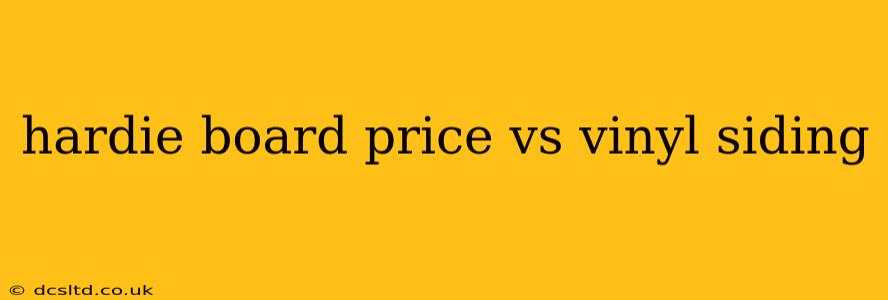Choosing between Hardie board and vinyl siding for your home's exterior is a significant decision, impacting both aesthetics and long-term costs. While both offer durable solutions, their initial price points and lifetime expenses differ considerably. This detailed comparison will delve into the pricing structures of each, factoring in installation, maintenance, and longevity to help you make an informed decision.
What is the average cost of Hardie board siding?
The average cost of Hardie board siding ranges significantly depending on several factors. These include the type of Hardie board (lap siding, shingles, panels, etc.), the size of your home, the complexity of the installation (e.g., requiring extra labor for intricate designs or difficult-to-access areas), and regional variations in labor costs and material availability. Generally, you can expect to pay anywhere from $8 to $15 per square foot for materials alone. Installation typically adds another $3 to $7 per square foot, bringing the total installed cost to $11 to $22 per square foot or more. Keep in mind, this is a broad estimate, and a precise quote requires a professional assessment of your specific project.
What is the average cost of vinyl siding?
Vinyl siding is generally more affordable upfront than Hardie board. Materials typically cost between $2 to $6 per square foot. Installation costs tend to be lower as well, usually ranging from $1 to $4 per square foot. Therefore, the total installed cost for vinyl siding typically falls between $3 to $10 per square foot. Again, this is an estimate, and accurate pricing depends on the specific project. Factors like the style of vinyl siding (e.g., clapboard, shakes), the complexity of the installation, and your location will affect the final price.
Hardie Board vs Vinyl Siding: Which is More Expensive in the Long Run?
While vinyl siding offers a lower initial investment, its lifespan and maintenance requirements contribute to higher long-term costs. Hardie board, despite its higher upfront cost, boasts significantly greater durability and longevity, translating to lower maintenance and replacement expenses over the decades. Vinyl siding is susceptible to cracking, fading, and damage from impacts, requiring more frequent repairs or replacements. Hardie board, being more resistant to these issues, significantly reduces these costs over its much longer lifespan.
What factors influence the overall cost?
Several factors influence the overall cost of both Hardie board and vinyl siding installation. These include:
- Home size: Larger homes naturally require more materials and labor, increasing the overall cost.
- Complexity of the project: Intricate designs, multiple angles, or difficult-to-access areas increase labor costs.
- Regional variations: Labor costs and material prices vary significantly across different regions.
- Additional features: Adding features like trim, soffit, and fascia will add to the overall expense.
- Permits and inspections: These necessary costs can vary depending on your location and project requirements.
What are the maintenance costs for Hardie board and vinyl siding?
Hardie Board: Requires minimal maintenance. Regular cleaning with a hose and occasional power washing can keep it looking its best. Repairs are less frequent due to its durability.
Vinyl Siding: May require more frequent cleaning to prevent dirt and grime buildup. It's susceptible to damage, necessitating occasional repairs or replacements of damaged panels.
How long does Hardie board and vinyl siding last?
Hardie Board: With proper installation and minimal maintenance, Hardie board can last 50 years or more.
Vinyl Siding: Typically lasts 20-30 years, depending on quality, installation, and environmental factors. However, its appearance often degrades well before its functional lifespan ends due to fading and cracking.
Does Hardie board increase home value more than vinyl siding?
Generally, yes. Hardie board is perceived as a higher-quality, more durable material, and therefore contributes to a greater increase in home value than vinyl siding. Appraisers and potential buyers recognize the longevity and superior performance of Hardie board, making it a desirable feature.
Conclusion
The choice between Hardie board and vinyl siding involves a careful consideration of initial costs versus long-term value. Vinyl siding is cheaper upfront, but Hardie board provides a more substantial return on investment due to its superior durability, longevity, and enhanced curb appeal, leading to lower maintenance costs and a higher resale value over time. Thoroughly evaluate your budget, home's specific needs, and long-term goals to make the optimal decision for your home.
